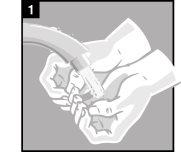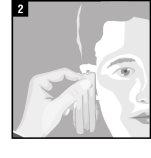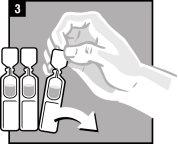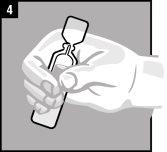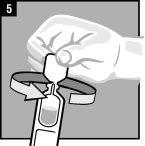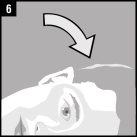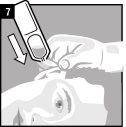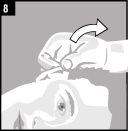
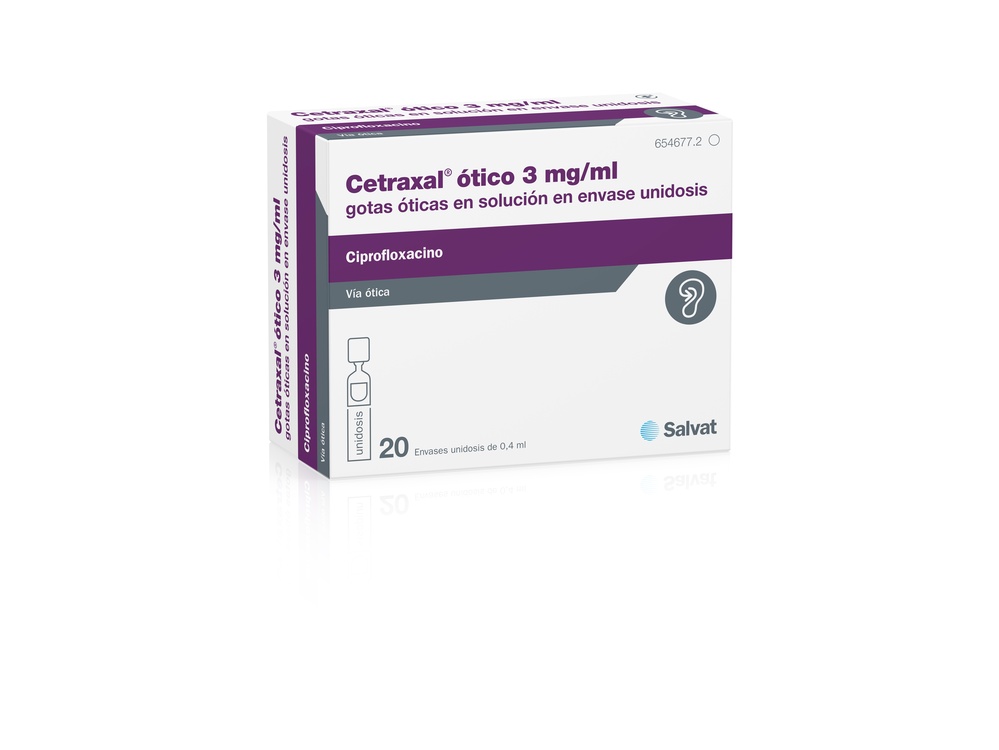
CETRAXAL OTIC 3 mg/ml OTIC DROPS IN SOLUTION IN SINGLE-DOSE CONTAINERS


How to use CETRAXAL OTIC 3 mg/ml OTIC DROPS IN SOLUTION IN SINGLE-DOSE CONTAINERS
Introduction
Package Leaflet: Information for the User
Cetraxal otic 3 mg/ml ear drops in solution in single-dose container
Ciprofloxacin
Read the entire package leaflet carefully before starting to use the medicine, as it contains important information for you
|
Contents of the package leaflet:
- What Cetraxal otic is and what it is used for
- What you need to know before using Cetraxal otic
- How to use Cetraxal otic
- Possible side effects
- Storage of Cetraxal otic
- Contents of the pack and further information
1. What Cetraxal otic is and what it is used for
Cetraxal otic is a solution for otic use (in the ear) containing ciprofloxacin, which belongs to the group of antibiotics called fluoroquinolones. Ciprofloxacin acts by eliminating bacteria that cause infections.
Cetraxal otic is indicated in adults and children from 2 years of age for the treatment of acute otitis externa (infection of the outer ear) and chronic suppurative otitis media (infection of the middle ear) of bacterial origin.
Antibiotics are used to treat bacterial infections and are not effective against viral infections such as the flu or common cold.
It is essential to follow the instructions regarding dosage, administration interval, and treatment duration indicated by your doctor.
Do not store or reuse this medicine. If you have any leftover antibiotic after completing the treatment, return it to the pharmacy for proper disposal. Do not throw away medicines via wastewater or household waste.
2. What you need to know before using Cetraxal otic
Do not use Cetraxal otic:
If you are allergic to ciprofloxacin or other quinolones or to any of the other components of this medicine (listed in section 6).
Warnings and precautions
- Consult your doctor or pharmacist before starting to use Cetraxal otic.
- This medicine should only be applied in the ear. It should not be ingested, injected, or inhaled. It should not be applied in the eye.
- If, once treatment has started, symptoms of urticaria (itching) or skin rash or any other allergic symptom (e.g., sudden swelling of the face, throat, or eyelids, difficulty breathing) occur, discontinue the medication immediately and consult your doctor. Severe hypersensitivity reactions may require immediate emergency treatment.
- Although sensitivity reactions to sunlight are not expected, it is recommended to take protective measures and avoid excessive exposure to direct sunlight while using this medicine.
- Inform your doctor if symptoms do not improve before completing the treatment. As with other antibiotics, infections may sometimes be caused by organisms that are not sensitive to ciprofloxacin. In such cases, the appropriate treatment should be prescribed by your doctor.
Children:
There is insufficient clinical experience with the use of Cetraxal otic in children under 2 years of age, so you should consult your doctor before administering this medicine to your child if they are of this age.
Other medicines and Cetraxal otic
Inform your doctor or pharmacist if you are using or have recently used or may need to use any other medicine.
It is not recommended to use Cetraxal otic with other ear medicines.
Pregnancy and breastfeeding
If you are pregnant or breastfeeding, think you may be pregnant, or plan to become pregnant, consult your doctor or pharmacist before using this medicine.
This medicine is not recommended during pregnancy and breastfeeding, so your doctor should assess the use of this medicine in each case.
Driving and using machines
There are no clinical data available. However, given the route of administration, it is unlikely that this medicine will affect the ability to drive vehicles or operate machinery.
3. How to use Cetraxal otic
Follow your doctor's or pharmacist's instructions for administering this medicine exactly. If in doubt, consult your doctor or pharmacist again.
Administration is done directly in the ear.
If you think the effect of this medicine is too strong or too weak, tell your doctor or pharmacist.
Your doctor will indicate the duration of treatment with Cetraxal otic. To ensure that the infection does not recur, do not interrupt treatment prematurely, even if you notice improvement in the ear(s).
The recommended dose is:
Adults
Acute otitis externa
Administer the contents of a single-dose container (0.4 ml) in the affected ear twice a day for 7 days.
Chronic suppurative otitis media
Administer the contents of a single-dose container (0.4 ml) in the affected ear twice a day for 10 days.
Elderly patients
No dose adjustment is necessary in this patient group.
Adolescents and children over 2 years
No dose adjustment is necessary in this patient group.
Children under 2 years
Its use is not recommended, as there are no data available for this age group.
Patients with kidney or liver disease
No dose adjustment is necessary in this patient group.
Method of administration
|
|
|
|
|
|
|
|
|
|
|
|
|
|
|
|
Discard the single-dose container after administration. | |
|
If you use more Cetraxal otic than you should:
Although it is difficult to overdose with this medicine, it is recommended that, in case of accidental ingestion or overdose, you consult your doctor or pharmacist immediately or call the Toxicology Information Service, phone 91 562 04 20, indicating the medicine and the amount used.
If you forget to use Cetraxal otic
Do not administer a double dose to make up for forgotten doses.
4. Possible side effects
Like all medicines, this medicine can cause side effects, although not everybody gets them.
The adverse reactions described are rare(may affect up to 1 in 100 people)
- Dizziness, headache, vertigo.
-Ear pain, passage of the product from the ear to the mouth.
-Eczema, skin rash, or itching, stinging sensation at the time of application.
Reporting of side effects
If you experience any side effects, consult your doctor or pharmacist, even if they are not listed in this package leaflet. You can also report them directly through the Spanish Pharmacovigilance System for Human Use Medicines: www.notificaram.es. By reporting side effects, you can help provide more information on the safety of this medicine.
5. Storage of Cetraxal otic
Keep this medicine out of the sight and reach of children.
Do not use this medicine after the expiry date stated on the container after EXP. The expiry date is the last day of the month indicated.
After opening the single-dose container: use immediately and discard the single-dose container after administration.
This medicine does not require special storage conditions. Keep the single-dose containers inside the protective sleeve, preferably inside the box.
Medicines should not be disposed of via wastewater or household waste. Deposit the containers and medicines you no longer need at the SIGRE collection point in the pharmacy. If in doubt, ask your pharmacist how to dispose of the containers and medicines you no longer need. This will help protect the environment.
6. Contents of the pack and further information
Composition of Cetraxal otic
- The active substance is ciprofloxacin. Each milliliter of solution contains 3 mg of ciprofloxacin.
- The other components are: lactic acid 90%, povidone, anhydrous glucose, sodium hydroxide solution, and purified water.
Appearance of the product and contents of the pack
Cetraxal otic is a medicine that comes in the form of ear drops in solution for administration in the ear. Each single-dose container contains 0.4 ml of sterile and transparent solution.
Marketing authorization holder and manufacturer
Laboratorios Salvat, S.A.
C/ Gall 30 – 36 - 08950
Esplugues de Llobregat
Barcelona - Spain
Date of the last revision of this package leaflet: July 2006.

How much does CETRAXAL OTIC 3 mg/ml OTIC DROPS IN SOLUTION IN SINGLE-DOSE CONTAINERS cost in Spain ( 2025)?
The average price of CETRAXAL OTIC 3 mg/ml OTIC DROPS IN SOLUTION IN SINGLE-DOSE CONTAINERS in October, 2025 is around 6.01 EUR. Prices may vary depending on the region, pharmacy, and whether a prescription is required. Always check with a local pharmacy or online source for the most accurate information.
- Country of registration
- Average pharmacy price6.01 EUR
- Active substance
- Prescription requiredYes
- Manufacturer
- CompositionHIDROXIDO DE SODIO (E 524) (4.0-5.0 - mg), GLUCOSA ANHIDRA (12.0 mg mg)
- This information is for reference only and does not constitute medical advice. Always consult a licensed doctor before taking any medication. Oladoctor is not responsible for medical decisions based on this content.
- Alternatives to CETRAXAL OTIC 3 mg/ml OTIC DROPS IN SOLUTION IN SINGLE-DOSE CONTAINERSDosage form: OTIC SOLUTION, 3 mg/mlActive substance: ciprofloxacinManufacturer: Zambon S.A.U.Prescription requiredDosage form: OTIC SOLUTION, 3 mgActive substance: ciprofloxacinManufacturer: Laboratorios Salvat S.A.Prescription requiredDosage form: OTIC SOLUTION, 1 mg/0.5 mlActive substance: ciprofloxacinManufacturer: Neuraxpharm Spain S.L.Prescription required


